Canon EOS Rebel SL3 3450C001 DSLR Camera Body
Original price was: $739.99.$480.99Current price is: $480.99.
Canon EOS Rebel SL3 3450C001 DSLR Camera Body Price comparison
Canon EOS Rebel SL3 3450C001 DSLR Camera Body Price History
Price History for Canon EOS Rebel SL3 DSLR Camera Body Only (Black)
Statistics
| Current Price | $480.99 | October 30, 2024 |
| Highest Price | $493.99 | June 23, 2024 |
| Lowest Price | $480.99 | August 1, 2024 |
Last price changes
| $480.99 | August 1, 2024 |
| $493.99 | June 23, 2024 |
Canon EOS Rebel SL3 3450C001 DSLR Camera Body Description
Make Professional-Grade Photos and Videos With The CANON EOS Rebel SL3
Capture all the details of your special moments with the CANON EOS Rebel SL3 DSLR Camera Body with built-in Wi-Fi. A lightweight and compact digital SLR, the EOS Rebel SL3 provides the performance you need for capturing stunning images. With its 24.1 megapixel CMOS sensor, along with the DIGIC 8 processor and ISO sensitivity of 100-25600, the EOS Rebel SL3 is ready to capture stunning images and videos with detail, colour and vibrancy. With the EOS Rebel SL3 you can easily capture professional-grade photos and videos with the large 3″ Vari-angle LCD touchscreen display, allowing you to frame your shots perfectly.
A Versatile DSLR With Built-In Wi-Fi
The CANON EOS Rebel SL3 DSLR Camera body features built-in Wi-Fi connectivity, allowing you to quickly and easily share your photos and videos. You can also control the camera from your smartphone or device with the Camera Connect App. The app gives you access to the camera’s settings, as you can easily transfer images and videos with ease to your smartphone or other devices. You’ll be able to instantly share your images, video clips, and other creative content with family and friends.
Capture Photos And Videos At Any Moment
The CANON EOS Rebel SL3 DSLR Camera Body offers the perfect combination of portability, speed, and features. Its Dual Pixel CMOS AF system allows for quick and accurate autofocus with up to 143 AF points for excellent performance in any light. The camera features an optical viewfinder to capture still photos or videos quickly and accurately. The high-speed shooting of 6fps and full HD 1080 video recording capabilities let you capture any moment with beautiful results. The EOS Rebel SL3 can also be controlled remotely with the EOS Utility.
Durability In A Compact Body
The CANON EOS Rebel SL3 DSLR Camera Body is perfect for photographers and videographers on the go. The camera is lightweight and compact, making it easy to transport and store. The camera also provides durability and enhanced protection with its dust- and water-resistant sealing. The camera also offers enhanced imaging performance with its EF mount lens compatibility. You can easily capture sharp images and videos with the CANON EOS Rebel SL3 DSLR.
Customize The Camera To Your Needs
The CANON EOS Rebel SL3 DSLR Camera Body offers customization for the photographer. You can control the camera settings directly on the 3″ Vari-angle LCD display, as well as control the camera remotely with a smartphone or device using the Camera Connect App. There are also a number of features to choose from, including Auto Lighting Optimizer, Picture Style, Exposure Compensation, and more. You can also adjust exposure and shutter speed manually and apply creative filters to your images and videos on the LCD display.
Experience Creative Freedom With The CANON EOS Rebel SL3
The CANON EOS Rebel SL3 DSLR Camera Body with Built-in Wi-Fi is the perfect addition to any photographer’s equipment. With its 24.1 megapixel CMOS sensor, DIGIC 8 processor, and ISO sensitivity of 100-25600, the camera offers excellent performance, portability, durability, and flexibility. Plus, you can customize the camera to your needs using its convenient features. The CANON EOS Rebel SL3 will help you capture photos and video at the highest quality, helping you bring your creative vision to life.
The Best Price For The CANON EOS Rebel SL3 DSLR Camera Body
The CANON EOS Rebel SL3 DSLR Camera Body is an excellent camera for capturing professional-grade photos and videos that you can confidently share with family and friends. On our website, you can compare the best prices on the CANON EOS Rebel SL3 DSLR Camera Body and find the best deals.
Frequently Asked Questions About The CANON EOS Rebel SL3 DSLR Camera Body:
-
What is the sensor size of the CANON EOS Rebel SL3 DSLR Camera Body?
The CANON EOS Rebel SL3 DSLR Camera Body has a 24.1 megapixel CMOS sensor.
-
What is the ISO range of the CANON EOS Rebel SL3 DSLR Camera Body?
The CANON EOS Rebel SL3 DSLR Camera Body has an ISO range of 100-25600.
-
What type of lenses are compatible with the CANON EOS Rebel SL3 DSLR Camera?
The CANON EOS Rebel SL3 DSLR Camera is compatible with EF mount lenses.
-
Does the CANON EOS Rebel SL3 DSLR have built-in Wi-Fi?
Yes, the CANON EOS Rebel SL3 DSLR Camera has built-in Wi-Fi for easy sharing and control.
-
Does the CANON EOS Rebel SL3 DSLR have a touchscreen display?
Yes, the CANON EOS Rebel SL3 DSLR Camera has a 3″ Vari-angle LCD touchscreen display.
Features Of The CANON EOS Rebel SL3 DSLR Camera Body:
- 24.1 megapixel CMOS sensor
- DIGIC 8 processor
- ISO sensitivity of 100-25600
- 3″ Vari-angle LCD touchscreen display
- Dual Pixel CMOS AF system with 143 AF points
- Optical viewfinder to capture still photos and videos
- High-speed shooting of 6fps
- Full HD 1080 video recording
- Built-in Wi-Fi connectivity
- EF mount lens compatibility
- Dust- and water-resistant sealing
- Remote control with EOS Utility
- Customizable features
Canon EOS Rebel SL3 3450C001 DSLR Camera Body Specification
Specification: Canon EOS Rebel SL3 3450C001 DSLR Camera Body
|
Canon EOS Rebel SL3 3450C001 DSLR Camera Body Reviews (11)
11 reviews for Canon EOS Rebel SL3 3450C001 DSLR Camera Body
Only logged in customers who have purchased this product may leave a review.

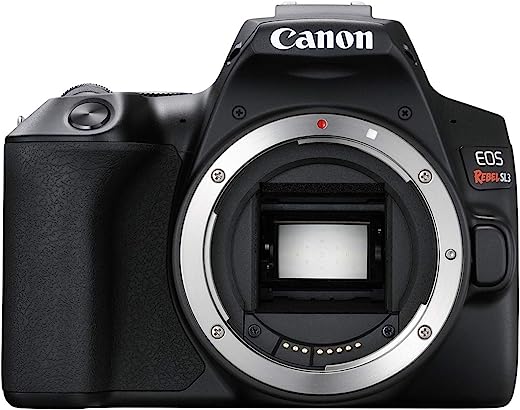
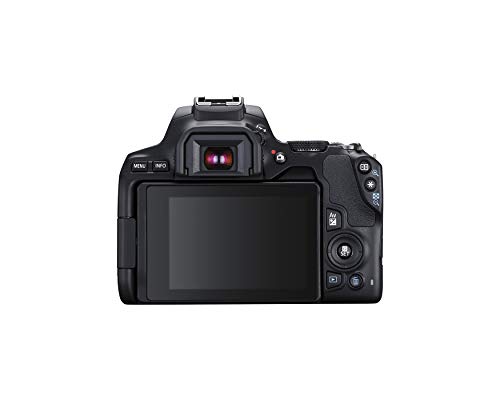
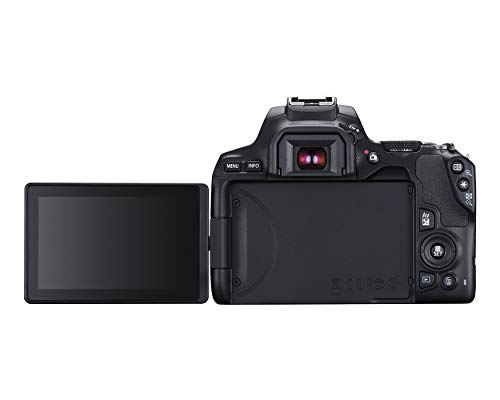
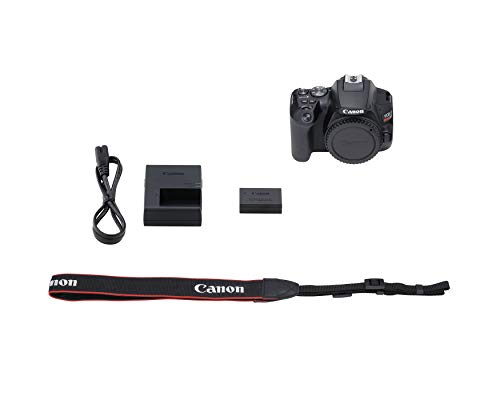




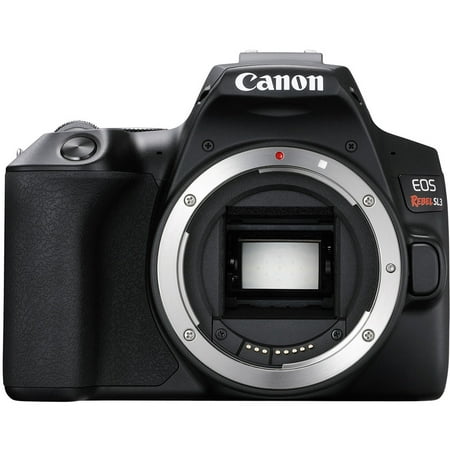












KJAG –
Canon makes a lot of “Prosumer” level cameras and with the USA Vs. International branding it can get very confusing.
For me it came down to the following “Have to have” points:
24 MegaPixel resolution:
24Mpx allows me to take one product picture and still have enough resolution to zoom in on a portion of the frame and still have Amazon spec (3k x 3k px) image size (resolution). I have an older Rebel (from the late 2000, plus a Rebel SL1 that I borrowed and an Equivalent Nikon from the mid-2010s. This is the only camera that allows me to take a single product picture and still have sufficient resolution to post on Amazon and other places. With the other cameras even the RAW version was not large enough to satisfy Amazon requirement for picture size (so I had to upsample my pictures) after allowing for a modicum of cropping. With the SL1 and the Nikon, I had to take 2 to 3 additional pictures to have a decent resolution sample of the product’s smaller features. My old Rebel is about as useful as a hole in the head these days. A shame. This camera is amazing when it comes to that.
Hinged Touchscreen:
The older SL1 Rebel is a nice camera, but feels cheaper and it has a fixed LCD screen. Since I shoot many products on the floor, with the camera at 90 degrees, being able to tilt the LCD screen for framing saves me time and resolution. I can close in tighter than I can with the SL1 because I can see the product better.
Even handheld shooting reminds me of the old days with my Rolleifles and Hasselblad. I don;pt kn ow how much fre hand photography I’ll do, but being able to get a lower POV without thrashing on the floor is nice. I remember spending $500 many years ago just to have a periscope viewfinder on an old Minolta film camera I used at the time. This is better.
Wi-Fi/Bluetooth connection:
This is the first thing I tested when I activated the camera and it works great. It lets me name pictures with a handy YY-MM-DD-filename format, which keeps all my pictures in Chronological order and they go into a folder properly named directly on my computer. With the Nikon I could do the same thing using an Open Source program, but I had to connect with a USB cable and frankly having one less cable in the studio is a blessing. Especially a cable connecting my laptop to the camera since I am continuously moving from behind the computer to the stage to place new products on it. I don’t know if I’ll use the bluetooth to my phone, but my wife might and it’s nice to have.
BTW, another thing I bought is a 2 batteries charger so now I have 3 batteries ready to go at all times. It’s must for serious shooting.
18-55mm Lens:
I almost didn’t buy a camera with a lens, because I already have a legacy of Canon lenses, including one that at the time cost me about three times what I paid for the camera body.
I wasn’t thrilled about the 18-55mm lens because it is the same as the one on the borrowed SL1. It’s actually useful for some of the shooting I am doing these days, but the lens feels cheap. The manual focusing ring on the SL1 lens felt like a cheap plastic toy that came with a happy meal.
GOOD NEWS: when I received the new camera, sporting the exact same lens, I was thrilled to find that in this new lens the focusing ring behaves much better. While the other lens’ focusing ring spins with almost no friction, the one that came with my camera is smooth and offers just enough resistance for proper manual focusing. I do wish it was a bit wider, but it’s a lot wider than other lenses I have and it’s very useful. I don’t know if I got lucky or what, since as best I can tell, they are identical lenses, but the one that came with this camera has excellent manual focusing.
All in all, I made a good choice because I can work with this lens for some of the shooting I do. I needed another 50mm equivalent lens like I need a third eye. I have a collection of them. Having this zoom is going to make my life easier and save me time when shooting many products one after the other.
Stability Control:
Sometimes I have to shoot hundreds of products in a short time. While I have a pretty good tripod setup, it’s in a small, hot room with lots of cables, lights reflectors, etc. I always shoot at 200 ISO, maybe 400 on a bad day so the exposure tends to be wide open and shutter speed very long.
Well, the stability control on all my lenses (of the digital generation) is very impressive. I had to shoot a number of T-shirts very quickly and given that it was 110 degrees inside the room, I simply could not bother to set up the tripod and do the usual “Leopard military walk” to change subject, align them, etc.
I decided to shoot them handheld. I was always good at it, but in this case I need to do it with my arms extended and the camera pointing down. Shutter speed 1/15. Crazy. Anything below 1/60 looks like a drunk was behind the lens.
I thought “no way I could end up with a sharp picture” with that setup, but I did. Even with the older SL1 (and no tilting LCD) I tested the handheld and tripod mounted version of the same picture side by side. Obviously, the tripod mounted one had better depth of field so it was as sharp as it could be, but I could only tell the difference if I enlarged things like the stitching of a coat. Once compressed and uploaded to a web site, the difference was not only negligible, it was invisible.
I am adding more lights so I can use a faster shutter speed, but I know that push come to shove, I can handhold the camera at 1/15 and get very sharp pictures. The Smithsonian may not be calling me anytime soon, but these pictures are not for museums.
Video:
This is the only disappointment, but not really a critical problem since I will seldom use the video feature and if I do, it’s certainly good enough for my purposes. Somehow, I thought the camera could shoot in 4K, but instead it only shoots in 1080p. I think one has to spend an extra $300 to get one that shoots in 4K. Bummer, but again, not a big concern for me and the video quality (on my 4K 32″ monitor) is still excellent. 4K would have been better but whaat the hell. I was already $200 over budget with the camera.
Software and Interface:
The camera interface, while not winning any prizes, is serviceable. I have not explored every little crevice, but it’s a lot better than my old Rebel and looks better organized than the SL1 I was using until my SL3 arrived.
I had to shoot with a Nikon for about a year (provided by my client) and that camera had a pretty bad interface, plus Nikon did not include remote shooting software with it. Or, I should say, they didn’t include it for free, which I think is criminal.
My older Rebel did and I was happy to see that this SL3 does too. Installation was a breeze as was connecting it to my desktop.
Now I am curious to see how it will handle connecting to my devices. I have a Desktop, a Laptop, a Music/Video production laptop, 2 ipads and a iPhone. I am slightly concerned about using my laptop as a remote control and repository for the pictures. I need it to easily switch from one computer to the other without too much fussing. I will update if this proves to be cumbersome, at which point I will slave the camera to my laptop instead of my desktop and save directly to my cloud drive, that way all computers will receive the same picture (I shoot with my laptop, I do post-production on my desktop and sometimes I master video on the other laptop attached to my music studio. It can be confusing)
Other than the above, it all seems serviceable and I am really happy with this camera.
It’s a plastic body Rebel, so if you are a war correspondent, maybe it’s not the camera for you. If you need 4K video, again, you want to spend a bit more for that.
But if you need excellent pictures and the features I listed above, this camera will do the job.
If you are thinking “Do I really need the tilting LCD?”, only you can answer that question. If you are a tourist or need to be light product shooting, maybe not, but for me it was important enough to pick this camera over the T7, which has pretty much similar characteristics but no tilting LCD.
I did a few shooting sessions with the SL1 and I missed the ability to tilt the LCD every single shot, and I am very experienced at shooting handheld, framing the photo in my mind. Someone with less experience (or not as steady hands) would have to take a lot of shots before ending up with a decent one.
Final thoughts: It’s a good camera for photographers. Videographers may want to look at the next camera up for 4K (assuming I am correct mine doesn’t do 4K)
Cliente de Amazon –
Es una cámara para principiantes, perfecto manejo y muy intuitiva. Recomendable para comenzar en la fotografía, no dudo que se puede usar de manera semi-profesional.
KJAG –
For better quality images and more artistic control over what a Smartphone (SP) or Point-and-Shoot (P&S) camera offers—the proven Digital Single Lens Reflex (DSLR) camera is the way to go, and the highly-rated Canon EOS Rebel SL3 is specifically designed with DSLR newbies in mind. The SL3 and native EFS lenses incorporate desirable features found in both P&S and conventional DSLR cameras, while shedding some of their less-favorable characteristics.
Mirrorless cameras are gaining traction w/similarities to DSLRs, and like the SL3, offer a smaller form factor. However, reviewers identify some growing pains, e.g., poor battery life, overheating, and a lack of native lens options. An adapter is required to use Canon’s EF or EFS DSLR lenses. But the bulkier, heavier (and costlier) EF lenses somewhat negate the benefits of having a more compact camera, while the more compact EFS lenses (designed for crop sensor DSLRs) limit the full capability of Mirrorless full-frame (FF) sensors. And unlike the SL3, there is presently no comparable Mirrorless model that offers more simplified operation and convenient features SP and P&S users prefer, and anyone new to DSLR/Mirrorless cameras will appreciate.
For portability and price SP and P&S cameras can’t be beat, but that comes with compromises. Some of the more expensive P&S cameras come w/megapixel (MP) counts and video capability similar to the SL3 (24.1MP for photos; 4K@25fps or Full HD@60fps video). However, the result is a bulkier P&S and pricing similar to the SL3 DSLR—but w/o the SL3’s additional features and technology that also factor into image and video quality:
• The SL3 has a much larger sensor (APS-C) than all but the most expensive P&S cameras, e.g., PowerShot G1 X Mark III, which uses the same sensor. But the Mark III is more expensive than the SL3 +EFS lens, and is bulky for a P&S camera.
• The SL3 and native EFS (or optional EF) lenses are better equipped to handle motion (photographer’s and/or subject) and dim lighting, w/fast, accurate autofocus, including auto-tracking of moving subjects.
• With the SL3, there are numerous compatible EF and EFS fixed, wide angle, and telephoto lenses to obtain the best quality imaging to best match your subjects of interest (e.g., urban settings, architecture, portraits, landscapes, wildlife, etc.) and shooting conditions (i.e., dim lighting, darkness, action, etc.). SP and P&S cameras rely on a single lens for all applications—sort of like the handyman who is a jack of all trades, but master of none. (FYI the biggest complaint among PowerShot G1 X Mark III reviewers is its integrated lens.)
• The SL3 offers the flexibility of add-on accessories to further improve image quality, e.g., lens filters and hoods, a boot for supplemental flash, etc.
• The SL3 can save images in JPEG and RAW format (even both formats simultaneously). RAW format provides the greatest ability to post-edit and enhance photos (w/capable photo editing software), as the files contain everything captured by the sensor w/no camera processing or compression. RAW format is preferred by many photo pros and nerds, although anyone can use it. RAW files are very large, so large memory cards are in order.
The SL3 is equipped with convenient features that SP and P&S camera owners are accustomed to and prefer:
• Form Factor: Although not as compact as P&S, the SL3 w/EFS lenses is the most compact and lightest DSLR system on the market, making it easier to handle and carry while also enabling use of a thinner, lighter strap and smaller case. The SL3 also has great ergonomics including a deep, rounded, rubberized finger grip that can accommodate a wide range of hand/finger sizes.
• Automated Settings: Like most cameras, the SL3 is equipped w/“Auto” mode to determine aperture, speed, ISO and if necessary, flash. But Auto mode can’t effectively adjust settings for all shooting conditions, e.g., moving subjects, low contrast, etc. or desired outcomes. The SL3 has an additional “Scene” mode to better optimize settings for scene of choice, e.g., portrait, landscape, handheld night scene, close-up, sports/action, and others. (These selections can be made on the touchscreen w/o opening the menus.)
• Sharing and Downloading: The SL3 is equipped w/built-in W-Fi, Bluetooth, and HDMI and USB ports. You can also transfer files using a memory card reader.
• LCD Touchscreen: A large 3″ LCD touchscreen provides menu navigation and the option of shooting in Live View vs. viewfinder, and snapping photos by touching the screen vs. shutter button. The screen displays focus point(s), which can be moved by touch to adjust composition, and displays shooting mode, settings and other info (e.g., battery life, remaining shots), and allows quick adjustments to key settings w/o opening menus. The screen is fully-articulating to enable selfies, vlogging, and taking difficult shots. Turning the screen up or down allows me to compose tough shots w/o kneeling, laying down, or standing on something. Images can be reviewed by swiping across the screen. You can adjust the screen’s brightness and touch sensitivity.
• Convenience and Practicality: Those new to DSLR/Mirrorless cameras will find a fairly steep learning curve that can be intimidating, w/manuals that can resemble a textbook and assumptions that you know more than you probably do. The SL3 helps bridge this gap with simplified menus, fewer seldom-used settings, pop-up descriptive/tutorial info (that can be modified/turned off), scene-specific automated settings, and other helpful features.
• Battery Life: The battery can support up to 1630 shots using the pentamirror viewfinder w/screen off, or 350 shots in Live View. I could not find related specs for video, but some reviewers indicate battery life is very good shooting video.
Capability: The SL3 is still a capable, versatile DSLR, and a great camera for mastering DSLR/Mirrorless basics if you later desire to move on to a more advanced (and more expensive) camera system. However, many will likely be content with the SL3 for years to come in providing sufficient artistic control and quality photos/video.
Bang-for-the-Buck: The SL3 w/kit lens costs more than typical P&S cameras, but less than the large majority of DSLR and Mirrorless cameras (w/kit lens or equivalent). At this time, the SL3 body can cost from $550 to $650, or $750 for the kit (w/EFS 18-55mm f/3.5-5.6 Lens). Most intermediate-level DSLR/Mirrorless kits or bodies w/kit-equivalent lens will set you back double or more. For the cost savings, you can buy 2 more EFS lenses for the SL3 along w/capable photo editing software and money left over for lens filters, hoods, strap, case, and more. And if you lose or damage the SL3 and/or lens, it will cost much less to replace them.
Additional Considerations: The SL3 and EFS lenses are built to withstand more physical abuse than most P&S cameras, and are generally as rugged as the more expensive DSLR/Mirrorless systems.
TRADE-OFFS
To reduce size and weight while providing a feature-packed DSLR system at an entry-level price point, Canon had to make a few trade-offs, but made sensible ones:
1. Fewer Setting Options and Features: The SL3 is not loaded down with seemingly endless setting options and nice but largely unnecessary bells and whistles found on more expensive DSLR and Mirrorless cameras that photo nerds and pros may desire, but the average person not so much.
2. Smaller Sensor: Cameras w/smaller sensors can be made smaller, lighter, and at less cost, and in turn, so can their native lenses. Most full-sized DSLR/Mirrorless cameras use a “full frame” sensor equivalent to yesteryears’ 35mm negative frame size and “field of view” (FOV). The SL3, along w/most entry level and some intermediate DSLRs use the ASP-C “crop” sensor. This sensor is still much bigger than those in most P&S cameras, but FF sensors are tops in capturing detail, especially in low-light, along w/expanded FOV. APS-C sensors offer an advantage over FF in Macro Photography, e.g., landscapes and other distant subjects, as they provide greater depth of field, i.e., sharper foregrounds and backgrounds relative to your subject.
3. Structural Composition: Smaller camera systems use less material, and less-costly ones use less expensive materials, though the predominant composition of most all DSLR/Mirrorless cameras and lens is polycarbonate (PC). PC is lightweight and less costly to make, yet very durable and resistant to abrasion, scratches, dents, and shock. You can often find more metal on costlier models, and even exclusive materials like magnesium alloy and/or carbon-fiber reinforced plastic (Sereebo). But their application may have as much or more to do with brand/model distinction than anything else. Metal is still used on all DSLR/Mirrorless cameras and lenses where essential, e.g., lens/camera interface.
4. Lens: Compared to the SL3’s native EFS lenses, Canon’s EF series are designed to take full advantage of FF sensors on all Canon DSLRs (including the most expensive pro cameras). EF lenses utilize better optics w/higher grade glass that enable lower F-stops w/wider apertures to improve light gathering, and an ultrasonic motor (USM) for focusing, which is a bit faster than the SL3’s stepped motor (STM)—although STM is preferred for video due to smoother AF. These attributes also make EF lenses bulkier, heavier, and more expensive (some lens cost more than the camera itself). EF lenses will fit and work on the SL3 (no adapter necessary), but FOV will not expand due to the smaller sensor. It should be noted most EFS lenses are highly rated by the majority of AMZ reviewers (I own four EFS lenses and concur), and like the SL3 camera are very good quality and a great value.
5. Weather Sealing: The SL3 is not fully weather sealed, so avoid using in rain.
THE GREAT EQUALIZERS
Despite some trade-offs, you will likely be surprised at the quality of images the SL3 and EFS lenses produce (along w/easier portability and handling, and lower cost). A few photos taken w/my SL3 system are attached. (FYI, photos of the fox and squirrels were taken through a double-pane window.)
1. The SL1 served my needs well for 6 years, but the SL3’s imaging and other features have markedly improved w/tech upgrades typically found in more expensive DSLR/Mirrorless cameras: 1) A DIGIC 8 Image Processor improves imaging speed and detail (esp. in low light), 2) the Dual Pixel CMOS AF improves focusing speed and accuracy, 3) improved ergonomics, 4) a new vari-angle screen, 5) improved resolution from 18MP to 24MP and from HD to 4K video, 6) longer battery life, 7) other improvements. Remarkably, the SL3 sells for only $50 more than the SL1 (still sold). The pricing and the fact the SL2 was sold for only 2 years before debut of the SL3 may indicate Canon felt its dominance in this market niche slipping due to new offerings by competitors. This may have precipitated loading up the SL3 with advanced features it may not have had otherwise, and/or bringing it to market faster than originally planned, and w/o significant mark-up. Ultimately, SL3 buyers greatly benefit.
2. Regardless of camera and lenses, advancements in Photo Editing Software can significantly improve image quality by compensating for underexposure, less-than-sharp imaging, noise, low contrast, inaccurate color rendering, etc., while also providing tools to simply enhance photos. For more information on Photo Editing Software, see “TIPS” below.
SUMMARY
Full-frame intermediate or pro DSLRs best meet the needs of photo pros, nerds, and anyone who wants the latest/greatest features and better/best artistic control and imaging. Of course, these systems are larger, heavier, costlier, and more complex.
Mirrorless cameras offer a smaller footprint and will eventually outsell DSLRs, but for now are still going through growing pains, and present models do not offer the native lens choices or simplified operation and features the SL3 does. Mirrorless cameras are priced similar to FF DSLRs.
The Canon EOS Rebel SL3 camera system may be your cup of tea if you’re mostly interested in:
• Sharing high quality photos on social media or similar applications
• A camera less complicated than typical DSLR/Mirrorless
• A compact/lighter camera system designed for portability
• Convenient features found on SP and P&S cameras
• A quality DSLR system at a fraction of the price
• Producing common-sized, quality prints
TIPS
1. Lenses: Instead of purchasing the Canon SL3 kit w/EFS 18-55mm f/3.5-5.6 lens, consider buying camera body separately and put the savings toward the highly-rated and more versatile EFS 18-135mm telephoto STM AF lens.
2. Lens Hoods and Filters: Being relatively cheap, hoods not only reduce flaring and other undesirable light effects, perhaps even more important they protect the lens from drops and scrapes that are inevitable. A hood has saved my lens on more than one occasion. Also invest in a quality UV lens filter, which also provides physical protection for your lens. Make sure the diameter (mm) matches your lens.
3. Save Images in Max Resolution: You’ll be surprised at how many Hi-Res photos you can save on a moderately-sized card. You can always reduce file size later, if desired. Image cropping itself reduces file size. Hi-Res provides maximum detail to take full advantage of editing software, and less likely that cropping or other editing will result in graininess, pixelation, or loss of detail. Hi-Res is also best if you want (or may later want) to print photos.
4. Photo Editing Software: Invest in quality software to clean up photos and even remove unwanted objects (e.g., people, utility poles/lines, vehicles, etc.). You can also enhance images to make them “pop.” I chose PhotoWorks (not FotoWorks) after much research. It’s powerful yet easier to use and cheaper than more well-known, but typically bloated and less user-friendly offerings, many that require recurring subscription fees. It’s much better than anything you can get for free, and far more than any editing or enhancement features found on cameras. You can edit both JPEG and RAW files, and convert RAW to JPEG format after editing. Dual mode allows you to see changes alongside the original, and when you decide to save your edited photo, it automatically saves the original along with it. I was skeptical at claims it can effectively remove utility lines from a photo, but it does, and well. I have a lifetime license for PhotoWorks Ultimate w/pro-level tools and ability to transfer the license to another device. This version costs $80 at this time. You can also download a free version to try out, or purchase a subscription for less, although these versions are missing some features.
5. Used Cameras/Lenses: Sellers typically rate condition by “physical appearance.” I purchased a “used, like new” lens only to discover there was no electrical communication between camera and lens, w/error code indicating it needs “servicing” by Canon. These items are generally no longer under Canon warranty. Sellers often stipulate you can return it within 30 days, but you may have to pay for shipping. At the very least, you may be largely inconvenienced and back to square one.
6. Pricing and Sellers: Canon (and other camera manufacturers) tightly control pricing so they can’t be sold for less than what Canon directly sells them for (if Canon is still selling the item). To get around this, many sellers include “free” add-ons, e.g., lens filters, strap, case, cleaning materials, lens hood, etc. Know these items generally come from the bottom of the barrel as far as quality and value. What’s more important is who the seller is and what their (not the product’s) ratings are. Click on the seller’s name where it is highlighted in blue to find out (if the rating is not posted on the product’s page). If their overall rating is not in the high 80s or above, it’s best to look for another seller. Also, avoid sellers that are new or w/only a handful of viewer ratings. While many are legit, others have re-entered the arena under a new profile/name after terrible reviews caught up to them and cut into sales. Also avoid foreign sellers and foreign versions of the item. Often these items are not under warranty, even if new.
Darwin –
Delivered a day early. Just as described. Happy with the kit.
Guardfather –
Buena calidad y facil de usar
Jonny –
I’m a beginner photographer and this is the only camera that fit my budget, great camera with a bunch of settings. Very easy to use and the camera even gives you some tips on how to shoot with different settings. Camera also tells you what everything is and how to use it.
Overall great product highly recommend!
Pat Wallace –
Cool pictures. Nice focus. 4K is not the best way to have the greatest vidéo… Better whit the option Ultra HD whit what I recorded. Good camera for the price.
Cliente de Kindle –
– Records up to 30 min video (lots of cameras have a 15 min limit)
– wi-fi & Bluetooth enabled (send media right to phone/computer)
– microphone jack (can connect external mic)
– clean HDMI out (can connect to monitor)
– very user friendly
Dora –
Muy satisfecha y agradecida por el tiempo de entrega. Muy buen producto, todo intacto. Feliz con mi compra
Emily R Pulliam –
This camera is fantastic. Since i bought one of the used options it was better priced but unfortunately wasn’t disclosed that it would come with an aftermarket battery and battery charger( basically useless ) so now I’ll have to buy that. Other than that, this was a great purchase!!
Sk3ptik0n –
I don’t spend enough time or effort on photography to justify spending thousands on a camera body. But I also want something better than an iPhone or my old Rebel XTi. This camera satisfies my needs, and impresses me in a few ways.
The main shortcomings are:
Video is limited to 30 minutes. Even if you disable power-saving mode, it will stop video (and I believe shut itself off) after 30 minutes. This is a measure done to avoid European regulatory measures that pertain to video recorders. As a U.S. citizen, I’m really irritated that Canon doesn’t provide firmware for customers who do not live in affected places. There is no good reason to cripple this device for the rest of us. If I want to record heat lightning, or a stream, or an animal habitat for as long as my memory card can handle, I should be able to do that. This is what prevents me from rating it 5 stars, and almost has me giving it 3.
Burst shooting isn’t going to be as fast or numerous as higher end cameras. For the price range, I’m not complaining. But it’s something to be aware of.
It’s a crop body. There are times I wanted full frame. But again, at this price point, I’m not really complaining.
It’s not weather-sealed. Again, price point issue. Higher end cameras can handle some light rain and humidity. This camera isn’t built to that standard. I’m basing that on reviews, as I’m not about to test it.